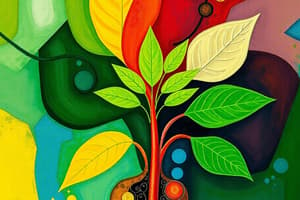Podcast
Questions and Answers
What is the primary function of roots in a plant?
What is the primary function of roots in a plant?
- To support flower production
- To anchor the plant and absorb nutrients (correct)
- To store glucose and oxygen
- To facilitate photosynthesis
Which part of the plant is primarily responsible for supporting it and transporting water and nutrients?
Which part of the plant is primarily responsible for supporting it and transporting water and nutrients?
- Roots
- Leaves
- Flowers
- Stem (correct)
What process do plants use to convert sunlight into food?
What process do plants use to convert sunlight into food?
- Pollination
- Photosynthesis (correct)
- Transpiration
- Respiration
What role do stomata play in a plant's leaves?
What role do stomata play in a plant's leaves?
How do flowers contribute to a plant's reproduction?
How do flowers contribute to a plant's reproduction?
What is the primary purpose of fruits for a plant?
What is the primary purpose of fruits for a plant?
Which pigment is responsible for capturing light energy in plants?
Which pigment is responsible for capturing light energy in plants?
During photosynthesis, what two substances do plants convert into glucose?
During photosynthesis, what two substances do plants convert into glucose?
What is the significance of chlorophyll in a plant's leaves?
What is the significance of chlorophyll in a plant's leaves?
What process allows flowers to produce seeds?
What process allows flowers to produce seeds?
Study Notes
Plant Structure and Function
- Roots anchor plants in the soil and absorb water and nutrients.
- Stems provide support, transport water and nutrients between roots and leaves, and position leaves to receive sunlight.
- Leaves are responsible for photosynthesis, capturing sunlight and exchanging gases.
- Flowers are involved in reproduction, producing seeds that grow into new plants.
- Fruits develop from flowers and contain seeds.
Photosynthesis
- Plants produce food through photosynthesis, using sunlight, carbon dioxide, and water to create glucose (sugar) and oxygen.
Gas Exchange in Leaves
- Stomata are tiny openings on the underside of leaves that allow for gas exchange.
- Carbon dioxide enters the leaf through stomata, while oxygen produced during photosynthesis exits through stomata.
Pollination and Reproduction
- Pollination is the transfer of pollen from the male part of a flower to the female part.
- Pollination is essential for fertilization and the production of seeds.
Photosynthesis
- Plants use sunlight to convert carbon dioxide and water into glucose and oxygen.
- This process primarily takes place in the leaves.
Importance of Flowers
- Flowers are essential for plant reproduction.
- They produce seeds through pollination and fertilization.
Fruits and Seed Dispersal
- Fruits protect seeds.
- They also aid in seed dispersal.
- Animals eating fruits carry and deposit seeds in new locations, facilitating plant propagation.
Role of Leaves
- Leaves are the primary sites for photosynthesis.
- They capture sunlight and exchange gases through stomata, enabling food production for the plant.
Chlorophyll
- Chlorophyll is the green pigment in leaves and is crucial for photosynthesis.
- It absorbs light energy from the sun.
Water Transport
- Water travels through a plant through a system of vascular tissues called xylem.
- Xylem transports water from the roots upwards to the rest of the plant.
Studying That Suits You
Use AI to generate personalized quizzes and flashcards to suit your learning preferences.
Related Documents
Description
Test your knowledge on the roles and functions of different plant structures, including roots, stems, leaves, and flowers. This quiz also covers essential processes like photosynthesis and gas exchange. Perfect for students studying plant biology!




